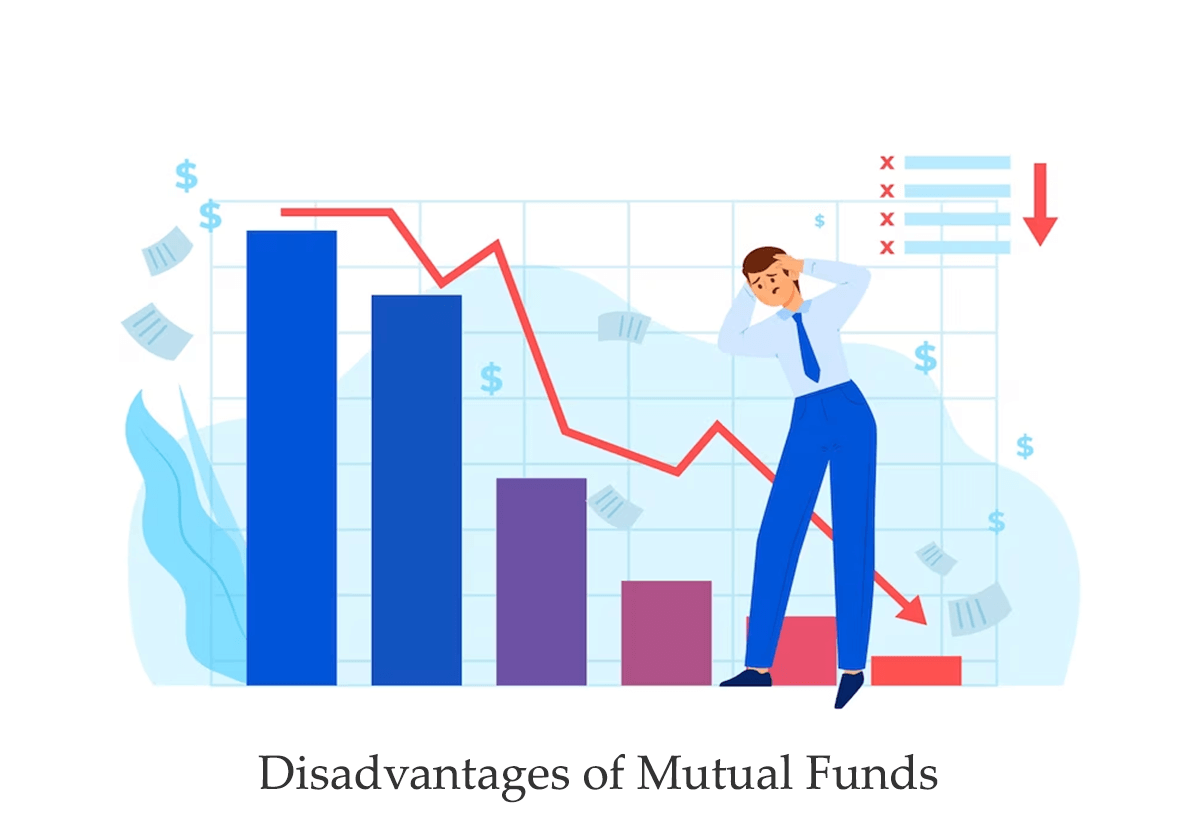What's Inside?
- What is Mutual Fund?
- Features of Mutual Funds
- Top Benefits of Mutual Funds
- Mutual Funds documents to start investing
- How to choose Mutual Funds?
- How to withdraw money from mutual funds?
- How to withdraw money from mutual funds offline?
- How to withdraw money from mutual funds online?
- Mutual Fund Tax Details
- Top things to know about Mutual Funds
- Disadvantages of Mutual Funds
- Top Mutual Funds investment mistakes to avoid
What is Mutual Fund?
“Mutual fund investments are subject to market risks. Kindly ensure thorough reading of all scheme-related documents prior to making any investment decisions.”
We often come across this statement that makes us feel uncertain about investing in mutual funds. It can make us worried about the possibility of losing money. However, mutual funds are not as complicated as they may seem. Let’s break it down!
Mutual Fund = Mutual (Group of people coming together) + Fund (Pooling of money)
Put simply, a mutual fund is a professionally overseen investment vehicle in which numerous individuals combine their funds. These funds are subsequently diversified across various assets such as stocks, bonds, and other investments.
The great thing about mutual funds is that you don’t need to be an expert in the stock market or have any prior knowledge. You can decide when to start investing, when to withdraw your money, and how much to invest according to your own preferences.
While it’s important to understand that there are risks involved in mutual fund investments, it’s equally important to read all the documents related to the specific mutual fund scheme before making your investment decision. This will help you make informed choices and understand how the fund works.
By investing in mutual funds, you can potentially grow your money and achieve your financial goals without having to worry about managing everything on your own.
Features of Mutual Funds
Professional Management: Mutual funds are managed by professional fund managers who have expertise in analyzing and selecting investments. They make investment decisions on behalf of the investors, aiming to achieve the fund’s objectives.
Diversification: Mutual funds bring together investments from various individuals to create a diversified portfolio consisting of stocks, bonds, and other assets. This diversification strategy aims to minimize risk by spreading it across different investments, thereby lessening the impact of poor performance from any single investment.
Liquidity: Mutual funds provide investors with the advantage of high liquidity, enabling them to purchase or liquidate their fund shares at the current net asset value (NAV) on any regular business day. This feature grants investors the flexibility and ease to tap into their investments whenever necessary.

Variety of Investment Options: Mutual funds offer a wide range of investment options, including equity funds, debt funds, balanced funds, index funds, sector-specific funds, and more. Investors can choose funds that align with their investment goals, risk tolerance, and time horizon.
Systematic Investment Plans (SIPs): Mutual funds offer SIPs, which allow investors to invest a fixed amount regularly at specified intervals. This helps in disciplined investing and eliminates the need to time the market.
Transparency: Mutual funds provide regular updates and reports to investors, including the fund’s performance, portfolio holdings, expense ratio, and other relevant information. This transparency enables investors to monitor their investments and make informed decisions.
Regulatory Oversight: Mutual funds are regulated by regulatory authorities such as the Securities and Exchange Board of India (SEBI) in India. These regulations aim to protect the interests of investors and ensure compliance with specified guidelines and disclosure norms.
Cost Efficiency: Mutual funds benefit from economies of scale, as the operating costs are shared among a large number of investors. This helps in reducing transaction costs and making mutual fund investments cost-efficient.
Flexibility in Investment Amount: Mutual funds allow investors to start with a relatively low investment amount, making it accessible for both small and large investors. This makes mutual funds an attractive investment option for a wide range of individuals.
Tax Efficiency: Some mutual funds offer tax benefits, such as tax-saving mutual funds (ELSS) that provide tax deductions under Section 80C of the Income Tax Act. Additionally, capital gains on equity-oriented mutual funds held for more than one year are tax-free.
Top Benefits of Mutual Funds
Mutual funds offer several benefits to investors. Here are some of the top advantages of investing in mutual funds:
Diversification: Mutual funds pool money from multiple investors to invest in a diversified portfolio of assets, such as stocks, bonds, or a combination of both. This diversification helps spread risk and reduces the impact of any individual investment’s performance on your overall portfolio.
Professional Management: Mutual funds are managed by experienced fund managers who have expertise in researching and selecting investments. They make investment decisions on behalf of the investors based on their knowledge and analysis. This allows investors to benefit from professional management without needing to have extensive investment knowledge themselves.

Affordability: Mutual funds are accessible to a wide range of investors, including those with smaller investment amounts. By pooling money from many investors, mutual funds provide the opportunity to invest in a diversified portfolio with relatively lower costs compared to individual investments.
Liquidity: Mutual funds are typically open-ended, meaning investors can buy or sell their units at the current net asset value (NAV) on any business day. This provides investors with liquidity and the ability to convert their investments into cash relatively easily.
Flexibility: Mutual funds offer a variety of investment options to suit different investment objectives, risk appetites, and time horizons. Investors can choose from different types of mutual funds, such as equity funds, debt funds, hybrid funds, index funds, sector-specific funds, etc., to align with their specific investment goals.
Transparency: Mutual funds are regulated and required to provide regular updates to investors. They disclose information about the fund’s portfolio, performance, expenses, and holdings. This transparency allows investors to make informed decisions and track the progress of their investments.
Convenience: Investing in mutual funds is convenient, as investors can buy, sell, or switch between funds through various channels, including online platforms, mobile apps, or through financial advisors. Additionally, investors can set up systematic investment plans (SIPs) to invest a fixed amount regularly, promoting disciplined investing.
Mutual Funds documents to start investing
When starting to invest in mutual funds, there are certain documents that you will need to go through and understand. Here are the main documents:
Offer Document/Prospectus: This document provides detailed information about the mutual fund scheme, its objectives, investment strategies, risk factors, and fees and expenses. It helps you understand the fund’s features and make an informed investment decision.

Scheme Information Document (SID): The SID contains specific details about the mutual fund scheme, including its asset allocation, investment policies, benchmark, and fund manager’s qualifications. It also explains the entry load, exit load, and other charges associated with the scheme.
Key Information Memorandum (KIM): The KIM provides a summary of the mutual fund scheme, highlighting its key features, investment objectives, risk factors, and historical performance. It is a concise document that gives you a quick overview of the scheme.
Statement of Additional Information (SAI): The SAI is a supplementary document that provides additional information about the mutual fund company, its operations, investment strategies, and financials. It contains detailed disclosures that may not be available in the prospectus or SID.
Application Form: The application form is required to invest in a mutual fund scheme. It captures essential details such as your personal information, investment amount, investment option, and bank account details. Complete the form with precision, ensuring all essential details are provided.
Know Your Customer (KYC) Documents: To comply with regulatory requirements, you need to complete the KYC process by submitting certain documents. These typically include proof of identity (such as PAN card), proof of address (such as Aadhaar card, passport, or utility bill), and a passport-sized photograph.
How to choose Mutual Funds?
Choosing mutual funds involves considering various factors. Here’s a guide on how to choose mutual funds:
Set Your Investment Goals: Determine your investment goals, such as wealth creation, retirement planning, or saving for a specific purpose. Clarify your time horizon and risk tolerance, as these factors will influence your choice of mutual funds.
Identify Fund Categories: Understand different mutual fund categories, such as equity funds, debt funds, balanced funds, index funds, or sector-specific funds. Each category has its own risk and return characteristics. Select investment funds that match both your financial objectives and your comfort level with risk.

Assess Fund Performance: Review the historical performance of mutual funds by examining their returns over different time periods. Look for consistency in performance and compare it with benchmark indices or peer funds. While previous achievements may offer insights, they do not ensure identical outcomes in the future.
Evaluate Fund Management: Assess the expertise and track record of the fund manager. A skilled and experienced fund manager can play a crucial role in the fund’s performance. Research the fund manager’s investment approach and their ability to navigate different market conditions.
Analyze Expenses: Consider the expense ratio of the mutual fund. Reducing expense ratios can enhance the total returns you receive. Compare expense ratios across similar funds to ensure you are getting good value for your money.
Check Fund Size and Liquidity: Consider the size of the fund and its liquidity. Larger funds may offer stability, better resources, and lower transaction costs. Adequate liquidity ensures ease of buying or selling fund units when needed.
Read Scheme Documents: Read the scheme-related documents, including the offer document, scheme information document, and factsheet. Understand the investment objective, asset allocation, risk factors, and other important details.
Seek Professional Advice: If you’re feeling unsure or not well-versed in mutual fund investments, seeking advice from a financial advisor is a wise step. Their expertise can offer tailored direction according to your financial objectives, aiding you in making well-informed choices.
Diversify Your Portfolio: Consider diversifying your investments across different mutual funds to spread the risk. Investing in a mix of equity, debt, and balanced funds can help balance your portfolio and reduce exposure to any single asset class.
Monitor Your Investments: Consistently assess your mutual fund portfolio to verify its alignment with your financial objectives. Keep abreast of market dynamics, economic shifts, and any alterations in the fund’s performance or approach.
How to withdraw money from mutual funds?
Investing in mutual funds offers a significant advantage called liquidity, which means you can easily get your money back when you need it. Here’s how you can redeem your investment:

Offline: You can visit the office of the Mutual Fund Company or any of its service centres to submit a Redemption Request. You can do this directly or through intermediaries who assist with the process.
Online: If you are registered with your PAN card and password details, you can submit a Redemption Request online. This provides a convenient way to redeem your investment.
After you submit the redemption request, the funds will be transferred to your designated bank account within three business days.
Before redeeming your mutual fund units, it’s a good idea to consult your investment adviser. They can guide you on any applicable tax regulations and other rules that may affect your redemption. This is important because you might need to pay additional taxes or exit loads based on the provisions mentioned in the scheme-related documents.
By consulting your investment adviser, you can ensure that you make informed decisions and understand the implications of redeeming your mutual fund units.
How to withdraw money from mutual funds offline?
To withdraw money from mutual funds offline, you can follow these steps:
- Obtain the mutual fund redemption form: You can obtain the redemption form from the mutual fund company’s office or its service center or by downloading it from their website.
- Fill out the redemption form: Fill out the form with all the necessary details such as your name, folio number, scheme name, scheme code, number of units you want to redeem, bank account details, etc.
- Submit the form: Once you have filled out the form, submit it either at the mutual fund company’s office or its service center or through any registered intermediary like a broker or distributor.
- Wait for the redemption proceeds: Once your request is processed, the mutual fund company will send the redemption proceeds to your registered bank account within a period of three business days.
How to withdraw money from mutual funds online?
Withdrawing money from mutual funds online is a simple process. Here’s a step-by-step guide:
- Log in to your mutual fund account: Visit the website of the mutual fund company or use their mobile app, and log in using your username and password.
- Navigate to the “Redemption” section: Once you’re logged in, look for the “Redemption” or “Withdrawal” option. It is usually found under the “Transactions” or “My Account” tab.
- Select the fund and amount: Choose the mutual fund scheme from which you want to withdraw money. Enter the amount you wish to redeem or select the number of units you want to sell.
- Confirm the transaction: Review the details of your redemption request, including the amount and the bank account where you want the money to be transferred. Make sure all the information is accurate.
- Authenticate the transaction: Depending on the mutual fund company, you may need to provide additional authentication. This can include entering an OTP (One-Time Password) sent to your registered mobile number or entering a transaction password.
- Submit the request: Once you have confirmed all the details and completed the authentication, submit the redemption request. The mutual fund company will process your request.
- Receive the funds: After the redemption request is processed, the money will be transferred directly to your registered bank account. The time taken for the funds to reflect in your account can vary but is typically within a few business days.
Mutual Fund Tax Details
Selling equity mutual funds within a year: If you sell your equity mutual fund holdings within one year, a flat rate of 15% short-term capital gain tax is applicable.

Selling equity mutual funds after a year: If you sell your equity mutual fund units after holding them for more than a year, long-term capital gain tax (LTCG) is applicable. For gains exceeding Rs.1 lakh in a financial year, a 10% tax is applied.
Selling debt mutual funds within three years: If you sell your debt mutual funds before completing three years of holding, the returns are added to your total income. Regular income tax is then applied based on your applicable tax slab.
Selling debt mutual funds after three years: If you sell your debt mutual funds after holding them for three years or more, the returns are treated as long-term capital gains. They are taxed at a rate of 20% after considering indexation, and cess of 3% is also added.
Top things to know about Mutual Funds
Assets Under Management (AUM): AUM is the total value of all the investments that a Mutual Fund Company manages for its clients. It shows how much money they are taking care of.
Alpha: Alpha is a way to measure how well a mutual fund performs compared to a benchmark like the Nifty. It tells us if the fund is generating extra returns or not.
Net Asset Value (NAV): NAV is the current price of one unit of a mutual fund. It tells you how much it costs to buy or sell one unit of the fund on a specific day.
Expense Ratio: Expense ratio is the fee that a Mutual Fund Company charges from investors for managing their investments. It covers the costs of running the fund, and it is expressed as a percentage of the total investment.
Risk Profile: Risk profile is an evaluation of how willing and capable an investor is to take risks. It helps in understanding the level of risk that is suitable for making investment decisions.
Exit Load: Exit load is a fee that a mutual fund company charges when an investor sells or redeems their investment. It is separate from the expense ratio and is paid at the time of exiting the fund.
Disadvantages of Mutual Funds
While mutual funds offer numerous advantages, there are also some potential disadvantages to consider:

- Market Risk: Mutual funds are subject to market risk, which means their value can fluctuate based on the performance of the underlying securities in the fund. If the market experiences a downturn, the value of your investment may decline.
- Fees and Expenses: Mutual funds charge various fees and expenses, including management fees, administrative fees, and distribution fees (also known as loads). These fees can reduce the overall returns on your investment.
- Lack of Control: When you invest in a mutual fund, you entrust the investment decisions to a professional fund manager. This means you have limited control over the individual securities held in the fund, and you cannot customize the portfolio according to your specific preferences.
- Over-diversification: Some mutual funds may become overly diversified, holding a large number of securities across different asset classes. While diversification is generally beneficial, excessive diversification can limit the potential for significant gains from individual securities.
- Capital Gains Tax: Mutual fund investors may be subject to capital gains tax if the fund manager sells securities within the fund at a profit. Even if you did not personally sell your shares, you may still be liable for taxes on the capital gains distributed by the mutual fund.
- Potential for Underperformance: While mutual funds are managed by professional fund managers, there is no guarantee that the fund will consistently outperform the market or achieve its investment objectives. Some funds may underperform their benchmarks or peers, resulting in lower returns for investors.
Top Mutual Funds investment mistakes to avoid
Here are some common mutual fund investment mistakes to avoid:
Lack of Research: Failing to research and understand the mutual fund you are investing in can lead to poor investment decisions. Take the time to study the fund’s objective, past performance, fund manager’s track record, expense ratio, and risk factors before investing.
Chasing Past Performance: Investing in mutual funds solely based on their past performance can be misleading. Past performance does not guarantee future success. Look for consistent performance and consider other factors such as the fund’s strategy, risk profile, and suitability for your investment goals.
Overlooking Risk Tolerance: Ignoring your risk tolerance can be a mistake. Mutual funds have different risk profiles, and it’s important to align them with your risk tolerance. Investing in high-risk funds when you have a low risk tolerance can lead to undue stress and potential losses.

Timing the Market: Trying to time the market by predicting short-term market movements is a challenging task. It’s difficult to accurately predict market highs and lows consistently. Instead, focus on long-term investing and stay invested through market cycles.
Overdiversification or Underdiversification: Overdiversification refers to holding too many mutual funds that have overlapping holdings, which can limit potential returns. On the other hand, underdiversification occurs when you have a limited number of funds, increasing your exposure to specific risks. Maintain a well-diversified portfolio across different asset classes and fund categories.
Neglecting Asset Allocation: Asset allocation is a crucial factor in portfolio construction. Failing to allocate your investments across different asset classes (such as equities, bonds, and cash) based on your risk tolerance and investment goals can hinder your portfolio’s performance and increase risk.
Frequent Trading: Excessive buying and selling of mutual funds can lead to higher transaction costs and tax implications. Avoid frequent trading unless there is a solid investment reason. Stick to your investment plan and avoid making impulsive decisions based on short-term market fluctuations.
Not Reviewing Investments: Neglecting to review your mutual fund investments periodically can lead to missed opportunities or holding underperforming funds for too long. Regularly assess your funds’ performance, monitor changes in market conditions, and make adjustments as necessary.
Ignoring Expense Ratios: Expense ratios represent the cost of managing a mutual fund and can impact your overall returns. Compare expense ratios across similar funds and choose funds with reasonable costs that provide value for your money.
Emotional Decision-Making: Allowing emotions, such as fear or greed, to drive your investment decisions can lead to poor choices. Develop a disciplined and rational approach based on your investment plan and long-term goals.

